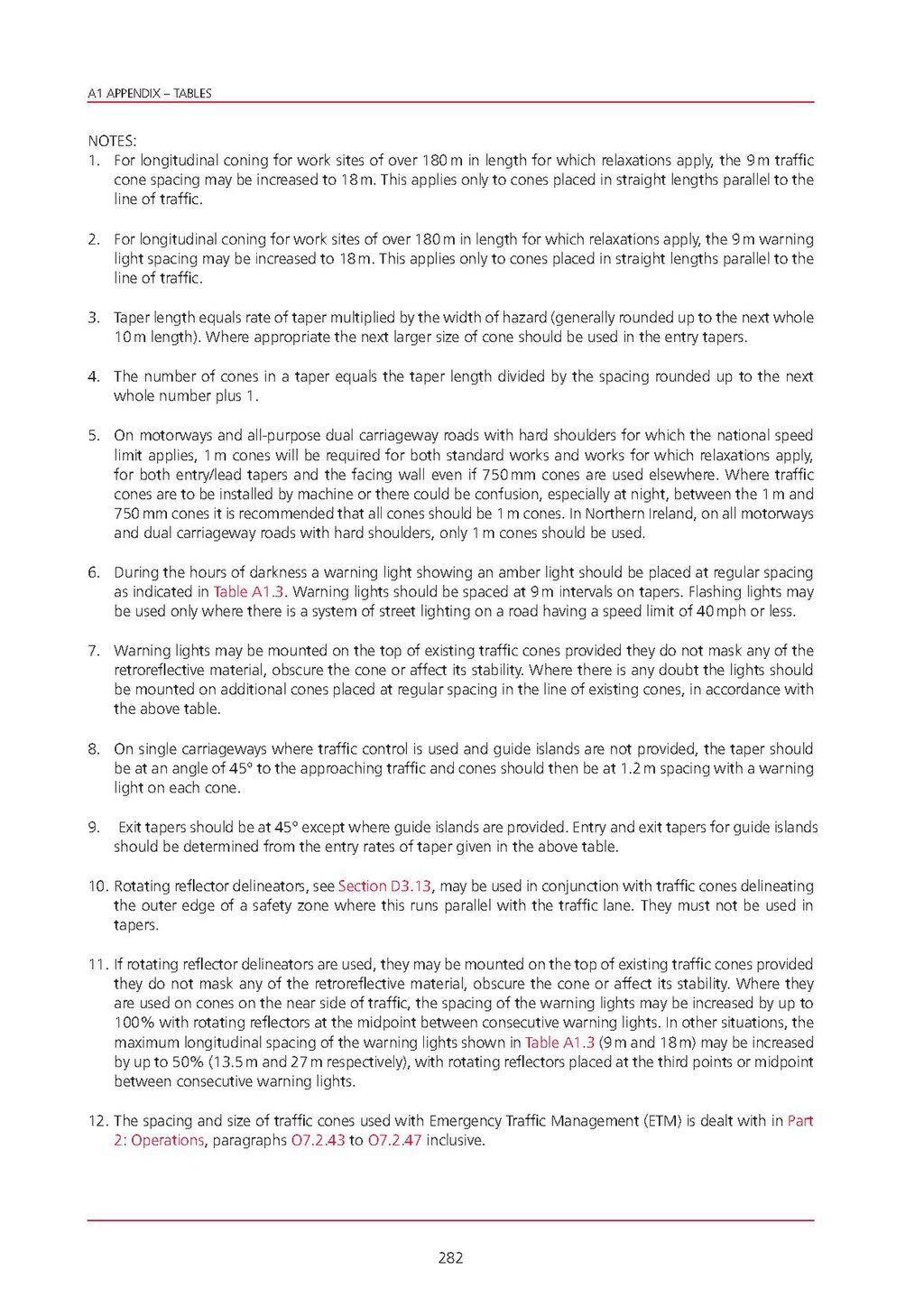A1 APPENDIX — TABLES
NOTES:
- For longitudinal coning for work sites of over 180m in length for which relaxations apply, the 9m traffic cone spacing may be increased to 18 m. This applies only to cones placed in straight lengths parallel to the line of traffic.
- For longitudinal coning for work sites of over 180m in length for which relaxations apply, the 9m warning light spacing may be increased to 18m. This applies only to cones placed in straight lengths parallel to the line of traffic.
- Taper length equals rate of taper multiplied by the width of hazard (generally rounded up to the next whole 10m length). Where appropriate the next larger size of cone should be used in the entry tapers.
- The number of cones in a taper equals the taper length divided by the spacing rounded up to the next whole number plus 1.
- On motorways and all-purpose dual carriageway roads with hard shoulders for which the national speed limit applies, 1 m cones will be required for both standard works and works for which relaxations apply, for both entry/lead tapers and the facing wall even if 750mm cones are used elsewhere. Where traffic cones are to be installed by machine or there could be confusion, especially at night, between the 1 m and 750 mm cones it is recommended that all cones should be 1 m cones. In Northern Ireland, on all motorways and dual carriageway roads with hard shoulders, only 1 m cones should be used.
- During the hours of darkness a warning light showing an amber light should be placed at regular spacing as indicated in Table A1.3. Warning lights should be spaced at 9m intervals on tapers. Flashing lights may be used only where there is a system of street lighting on a road having a speed limit of 40 mph or less.
- Warning lights may be mounted on the top of existing traffic cones provided they do not mask any of the retroreflective material, obscure the cone or affect its stability. Where there is any doubt the lights should be mounted on additional cones placed at regular spacing in the line of existing cones, in accordance with the above table.
- On single carriageways where traffic control is used and guide islands are not provided, the taper should be at an angle of 45° to the approaching traffic and cones should then be at 1.2 m spacing with a warning light on each cone.
- Exit tapers should be at 45° except where guide islands are provided. Entry and exit tapers for guide islands should be determined from the entry rates of taper given in the above table.
- Rotating reflector delineators, see Section D3.13, may be used in conjunction with traffic cones delineating the outer edge of a safety zone where this runs parallel with the traffic lane. They must not be used in tapers.
- If rotating reflector delineators are used, they may be mounted on the top of existing traffic cones provided they do not mask any of the retroreflective material, obscure the cone or affect its stability. Where they are used on cones on the near side of traffic, the spacing of the warning lights may be increased by up to 100% with rotating reflectors at the midpoint between consecutive warning lights. In other situations, the maximum longitudinal spacing of the warning lights shown in Table A1.3 (9m and 18m) may be increased by up to 50% (13.5 m and 27 m respectively), with rotating reflectors placed at the third points or midpoint between consecutive warning lights.
- The spacing and size of traffic cones used with Emergency Traffic Management (ETM) is dealt with in Part 2: Operations, paragraphs 07.2.43 to 07.2.47 inclusive.
282
